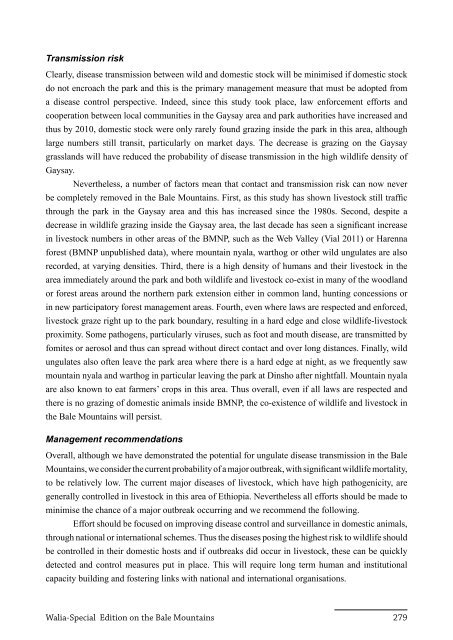Walia Special Edition on the Bale Mountains (2011) - Zoologische ...
Walia Special Edition on the Bale Mountains (2011) - Zoologische ...
Walia Special Edition on the Bale Mountains (2011) - Zoologische ...
You also want an ePaper? Increase the reach of your titles
YUMPU automatically turns print PDFs into web optimized ePapers that Google loves.
Transmissi<strong>on</strong> risk<br />
Clearly, disease transmissi<strong>on</strong> between wild and domestic stock will be minimised if domestic stock<br />
do not encroach <strong>the</strong> park and this is <strong>the</strong> primary management measure that must be adopted from<br />
a disease c<strong>on</strong>trol perspective. Indeed, since this study took place, law enforcement efforts and<br />
cooperati<strong>on</strong> between local communities in <strong>the</strong> Gaysay area and park authorities have increased and<br />
thus by 2010, domestic stock were <strong>on</strong>ly rarely found grazing inside <strong>the</strong> park in this area, although<br />
large numbers still transit, particularly <strong>on</strong> market days. The decrease is grazing <strong>on</strong> <strong>the</strong> Gaysay<br />
grasslands will have reduced <strong>the</strong> probability of disease transmissi<strong>on</strong> in <strong>the</strong> high wildlife density of<br />
Gaysay.<br />
Never<strong>the</strong>less, a number of factors mean that c<strong>on</strong>tact and transmissi<strong>on</strong> risk can now never<br />
be completely removed in <strong>the</strong> <strong>Bale</strong> <strong>Mountains</strong>. First, as this study has shown livestock still traffic<br />
through <strong>the</strong> park in <strong>the</strong> Gaysay area and this has increased since <strong>the</strong> 1980s. Sec<strong>on</strong>d, despite a<br />
decrease in wildlife grazing inside <strong>the</strong> Gaysay area, <strong>the</strong> last decade has seen a significant increase<br />
in livestock numbers in o<strong>the</strong>r areas of <strong>the</strong> BMNP, such as <strong>the</strong> Web Valley (Vial <strong>2011</strong>) or Harenna<br />
forest (BMNP unpublished data), where mountain nyala, warthog or o<strong>the</strong>r wild ungulates are also<br />
recorded, at varying densities. Third, <strong>the</strong>re is a high density of humans and <strong>the</strong>ir livestock in <strong>the</strong><br />
area immediately around <strong>the</strong> park and both wildlife and livestock co-exist in many of <strong>the</strong> woodland<br />
or forest areas around <strong>the</strong> nor<strong>the</strong>rn park extensi<strong>on</strong> ei<strong>the</strong>r in comm<strong>on</strong> land, hunting c<strong>on</strong>cessi<strong>on</strong>s or<br />
in new participatory forest management areas. Fourth, even where laws are respected and enforced,<br />
livestock graze right up to <strong>the</strong> park boundary, resulting in a hard edge and close wildlife-livestock<br />
proximity. Some pathogens, particularly viruses, such as foot and mouth disease, are transmitted by<br />
fomites or aerosol and thus can spread without direct c<strong>on</strong>tact and over l<strong>on</strong>g distances. Finally, wild<br />
ungulates also often leave <strong>the</strong> park area where <strong>the</strong>re is a hard edge at night, as we frequently saw<br />
mountain nyala and warthog in particular leaving <strong>the</strong> park at Dinsho after nightfall. Mountain nyala<br />
are also known to eat farmers’ crops in this area. Thus overall, even if all laws are respected and<br />
<strong>the</strong>re is no grazing of domestic animals inside BMNP, <strong>the</strong> co-existence of wildlife and livestock in<br />
<strong>the</strong> <strong>Bale</strong> <strong>Mountains</strong> will persist.<br />
Management recommendati<strong>on</strong>s<br />
Overall, although we have dem<strong>on</strong>strated <strong>the</strong> potential for ungulate disease transmissi<strong>on</strong> in <strong>the</strong> <strong>Bale</strong><br />
<strong>Mountains</strong>, we c<strong>on</strong>sider <strong>the</strong> current probability of a major outbreak, with significant wildlife mortality,<br />
to be relatively low. The current major diseases of livestock, which have high pathogenicity, are<br />
generally c<strong>on</strong>trolled in livestock in this area of Ethiopia. Never<strong>the</strong>less all efforts should be made to<br />
minimise <strong>the</strong> chance of a major outbreak occurring and we recommend <strong>the</strong> following.<br />
Effort should be focused <strong>on</strong> improving disease c<strong>on</strong>trol and surveillance in domestic animals,<br />
through nati<strong>on</strong>al or internati<strong>on</strong>al schemes. Thus <strong>the</strong> diseases posing <strong>the</strong> highest risk to wildlife should<br />
be c<strong>on</strong>trolled in <strong>the</strong>ir domestic hosts and if outbreaks did occur in livestock, <strong>the</strong>se can be quickly<br />
detected and c<strong>on</strong>trol measures put in place. This will require l<strong>on</strong>g term human and instituti<strong>on</strong>al<br />
capacity building and fostering links with nati<strong>on</strong>al and internati<strong>on</strong>al organisati<strong>on</strong>s.<br />
<str<strong>on</strong>g>Walia</str<strong>on</strong>g>-<str<strong>on</strong>g>Special</str<strong>on</strong>g> <str<strong>on</strong>g>Editi<strong>on</strong></str<strong>on</strong>g> <strong>on</strong> <strong>the</strong> <strong>Bale</strong> <strong>Mountains</strong> 279
















